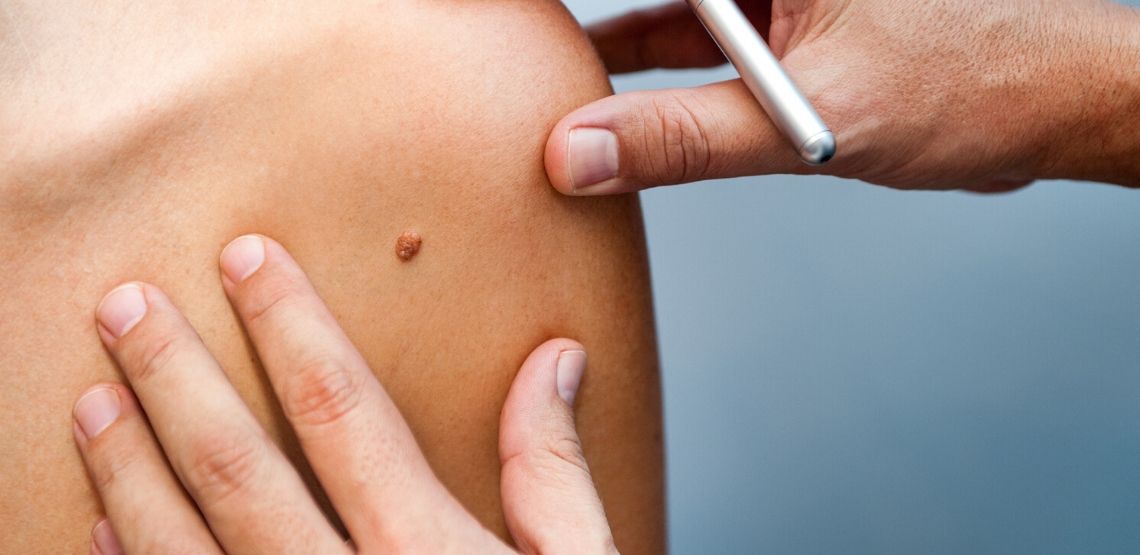Skin Cancer Symptoms
Skin cancer symptoms involve abnormal skin cells in the outermost skin layer called the epidermis. Catching skin cancer early is important for treatment, so it's important to know how to spot the symptoms. In this article, we look at eight common skin cancer symptoms.
According to the American Academy of Dermatology, in the United States, skin cancer is the most common form of cancer. There are different types of skin cancer including basal cell, squamous cell and melanoma. According to the Skin Cancer Foundation, the two top causes of skin cancer is exposure to UV rays from the sun and tanning booths.
Both squamous cells and basal cells tend to appear on areas of the body that receive the most sun exposure, such as the neck, shoulders and face. Melanoma skin cancer can also develop in areas of the body exposed to the sun, but it is also found in other parts that do not receive as much sun exposure.
8 Skin Cancer Symptoms to Watch for
Melanoma is the most serious form of skin cancer. This being said any type of skin cancer can become significant and even lead to disfigurement if it is not treated. The good news is that when it is caught early, most forms of skin cancer are treatable, and the prognosis is good. That is why it is so critical to know what signs of skin cancer to watch for.
Although most moles are not harmful, some can be cancerous. So, it is essential to determine the difference. For instance, normal moles tend to be even in color and either raised or flat, but not both. Most are also no bigger than the width of a pencil eraser.
Signs a mole may be suspicious and could be a sign of skin cancer include the following:
- A change in a mole: Usually, harmless moles do not change over time. But a mole or skin growth that changes color or shape may be a sign of skin cancer. Also, if a mole starts to bleed, crust or become shiny, it could be an indication that it requires further evaluation by a doctor.
- Asymmetry: Typically, moles that are noncancerous match on both sides. When two halves of the mole are not the same, it could indicate melanoma.
- A growth that has a lower center and raised edges: Most moles are either raised or flat throughout. A possible sign of skin cancer is a mole that has raised borders and a lower center. It may also have pink growths around the edges due to abnormal blood vessel growth.
- A sore that does not heal: Most skin sores heal over time. But if a sore does not get better or becomes worse, it could be a sign of some form of skin cancer. For example, if a mole crusts, oozes or if it heals and then becomes worse again, you should have it checked.
- A rough or scaly patch of skin: Not all skin cancers involve a change in a mole. A growth that is firm, flat and looks like a scar can be a sign of squamous skin cancer.
- A mole that has uneven color: Most moles that are noncancerous are some shade of brown consistently throughout the growth. But cancerous moles may not be the same color over the entire mole. For instance, the mole may be dark brown, black or light brown in spots. Melanoma may also have patches of red, pink or white.
- Uneven edges: Normal moles tend to have regular and even borders or edges. If a mole has a ragged or irregular edge, it can be an indication of melanoma.
- A mole or growth that is six millimeters or larger: Not all large moles are cancerous, and melanomas can also be small. But it is still best to have a mole that is larger than six millimeters across checked out by a dermatologist.
Related Search Topics (Ads)
Foods to Maintain a Healthier Diet
A healthy diet can play a supportive role in overall skin health and may help reduce the risk of developing certain types of cancer. Here are some general dietary recommendations that can promote skin health and potentially reduce the risk of skin cancer:
- Antioxidant-rich foods: Include plenty of fruits and vegetables in your diet, as they are high in antioxidants. These can help neutralize harmful free radicals and reduce cellular damage. Opt for colorful options like berries, leafy greens, tomatoes, citrus fruits and bell peppers.
- Omega-3 fatty acids: Foods rich in omega-3 fatty acids, such as fatty fish (salmon, mackerel, sardines), flaxseeds, chia seeds and walnuts, have anti-inflammatory properties and may contribute to healthier skin.
- Vitamin D: Adequate vitamin D levels are essential for overall health, including skin health. While sunlight is the primary source of vitamin D, certain foods can also provide small amounts. These include fatty fish, fortified dairy products, fortified plant-based milk and egg yolks.
- Limit processed and red meats: There is some evidence suggesting that a high intake of processed and red meats may increase the risk of certain cancers, including skin cancer. It's generally recommended to moderate the consumption of these meats and opt for lean protein sources like poultry, fish, legumes and tofu.
- Reduce sugary and high-glycemic foods: High-glycemic foods, such as refined carbohydrates and sugary snacks, can cause spikes in blood sugar levels, which may promote inflammation and potentially affect skin health. Focus on whole grains, fruits and vegetables as your main sources of carbohydrates.
- Stay hydrated: Drinking an adequate amount of water is important for maintaining healthy skin. It helps keep your skin hydrated and can aid in the overall health of your body's cells.
Treatment Options
The treatment options for skin cancer can vary depending on the type, stage and location of the cancer. The most common treatment approaches for skin cancer include:
- Surgery: Surgical procedures are often the primary treatment for skin cancer. The goal is to remove the cancerous growth along with a margin of healthy tissue to ensure complete removal.
- Radiation therapy: This treatment involves using high-energy X-rays or other types of radiation to kill cancer cells. It is often used in cases where surgery may be challenging or when the cancer has spread to nearby lymph nodes.
- Topical medications: Certain types of non-melanoma skin cancers, such as superficial basal cell carcinoma or actinic keratosis, can be treated with topical creams or gels. These medications, such as imiquimod, fluorouracil or ingenol mebutate, are applied directly to the affected area to destroy cancer cells.
- Cryotherapy: Cryotherapy involves freezing the cancer cells with liquid nitrogen. It is commonly used for superficial skin cancers or precancerous lesions.
- Photodynamic therapy (PDT): PDT involves applying a photosensitizing agent to the skin, which is then activated by a special light source. The activated agent destroys cancer cells.
- Targeted therapy: In cases of advanced or metastatic skin cancer, targeted therapies may be prescribed. These medications work by targeting specific genetic mutations or proteins present in cancer cells.
- Immunotherapy: Immunotherapy drugs help boost the body's immune system to recognize and attack cancer cells. They can be used for advanced melanoma and Merkel cell carcinoma.
8 Common Triggers for Skin Cancer
Here are some common triggers or risk factors associated with skin cancer:
- Sun exposure: Prolonged or excessive exposure to UV radiation from the sun is a major risk factor for skin cancer. This includes exposure to both natural sunlight and artificial sources of UV radiation, such as tanning beds and sunlamps.
- Sunburns: Experiencing sunburns, especially during childhood or adolescence, increases the risk of developing skin cancer later in life. Intense, intermittent exposure to the sun that leads to blistering or peeling is particularly harmful.
- Fair skin: People with fair skin, light-colored eyes and naturally red or blond hair are more susceptible to the harmful effects of UV radiation. The higher levels of melanin in darker skin provide some natural protection against UV damage.
- Family history: Having a family history of skin cancer, particularly melanoma, increases the risk of developing the disease. Certain inherited genetic mutations, such as those in the CDKN2A or CDK4 genes, can also contribute to a higher risk.
- Age: The risk of developing skin cancer increases with age. This is mainly due to cumulative exposure to UV radiation over time.
- Immune suppression: Individuals with weakened immune systems, such as those who have undergone organ transplantation or are living with HIV/AIDS, have an increased risk of developing skin cancer.
- Previous skin cancer: A personal history of skin cancer, including basal cell carcinoma, squamous cell carcinoma or melanoma, raises the risk of developing additional skin cancers.
- Precancerous skin lesions: Actinic keratosis, also known as solar keratosis, is a common precancerous skin condition caused by long-term sun exposure. If left untreated, it may progress to squamous cell carcinoma.
When to See a Doctor
Some moles may be present at birth, but many others may appear in childhood or young adulthood. Once they develop, they typically stay the same shape and size. Other skin growths, such as freckles and skin tags, may also develop at any time in a person’s life. While it may not be necessary to take notice of every new freckle, you should do self-skin cancer checks to look for abnormalities.
According to the American Academy of Dermatology (AAD), about 50% of melanoma skin cancers are self-detected. That is why skin self-exams are so vital. According to the Skin Cancer Foundation, adults should do self-exams from head to toe about once a month to check for skin abnormalities.
If you find any of the above abnormalities, including changes in a mole, sores that do not heal or a bleeding mole, it is vital to see your doctor as soon as possible. It is also important to talk with your doctor about how often you should have a skin cancer screening. The frequency of screening may depend on several factors, such as your family history and extent of your sun exposure.


